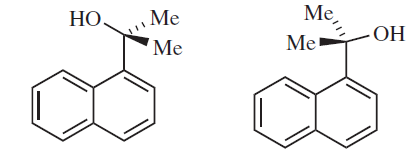In March's Advanced Organic Chemistry (6th ed.), it's stated that the above two are atropisomers. I don't get why is it so. How is the topmost $\ce{C}$ locked in its place? Surely, there's steric hindrance due to presence of two methyls but how does that prevent rotation? It can certainly rotate with the methyls being "rigid" in their positions. Also, are they chiral? I believe they aren't because they are superimposable mirror images.
1 Answer
The hindered rotation is due to the hydrogens at the naphthyl moiety. The following shows the rotation calculated at the DF-B97D3/def2-SVP level of theory. To better visualise this, I have chosen a mode with large atoms (not actually using the van-der-Waals radii, because that looked very strange; click here for a ball and stick version):
We can observe three minima and three transition states corresponding to that rotation, the depiction you have posted is slightly inaccurate as it shows one local minimum and a transition state.
From the three states that should be observable, the global minimum is achiral (1), while the other two are enantiomers (2, 3). The latter are connected via a low lying transition state (TS-2-3); probably because of the hydrogen bonding interaction guiding it. The global minimum on the other hand is separated via a very high energy barrier. These transition states (TS-1-2, TS-3-1) are again enantiomeric to each other.
I have calculated the associated energy barriers in $\pu{kJ/mol}$ at the DF-B97D3/def2-TZVPP level of theory. \begin{array}{c*{6}{r}}\hline \text{State} & \Delta E_\mathrm{o} & \Delta G^{\pu{50 K}}& \Delta G^{\pu{75 K}}& \Delta G^{\pu{100 K}}& \Delta G^{\pu{298.15 K}}& \Delta G^{\pu{500 K}}\\\hline % \mathbf{(1)} & 0.0 & 0.0 & 0.0 & 0.0 & 0.0 & 0.0\\ \mathbf{\text{(TS-1-2)}} & 32.9 & 32.9 & 32.9 & 33.1 & 35.7 & 39.7\\ \mathbf{(2)} & 0.7 & 0.7 & 0.7 & 0.8 & 1.4 & 2.3\\ \mathbf{\text{(TS-2-3)}} & 12.0 & 12.1 & 12.1 & 12.3 & 14.9 & 18.9\\ \mathbf{(3)} & 0.8 & 0.8 & 0.8 & 0.8 & 1.5 & 2.3\\ \mathbf{\text{(TS-3-1)}} & 32.9 & 32.9 & 33.0 & 33.1 & 35.7 & 39.8\\\hline \end{array}
From these values we can estimate rate constants for the energy barrier with the Eyring equation, which employs the transition state theory: $$ k = \kappa \frac{k_\mathrm{B}T}{h}\exp\left\{\frac{-\Delta G}{RT}\right\}$$
I use $\kappa = 1$, i.e. I am ignoring it, to get a guesstimate at which temperature we will be able to distinguish between all, or some of the states.
\begin{array}{c*{5}{l}}\hline k/\pu{s-1};\ T= & \pu{50 K}& \pu{75 K}& \pu{100 K}& \pu{298.15 K}& \pu{500 K}\\\hline % \mathbf{(1) \to (2)} & \pu{4.9E-23} & \pu{1.8E-11} & \pu{1.1E-5} & \pu{3.5E6} & \pu{7.5E8}\\ \mathbf{(2) \to (3)} & \pu{2.6E-1} & \pu{5.4E3} & \pu{7.8E5} & \pu{1.5E10} & \pu{1.1E11}\\ \mathbf{(3) \to (1)} & \pu{2.8E-22} & \pu{5.9E-11} & \pu{2.8E-5} & \pu{6.1E6} & \pu{1.3E9}\\ \hline \end{array}
From this we can see, that at room temperature the rotation is pretty much free with a couple million transitions per second. At around $\pu{100 K}$ the is hindered; from the global minimum (1) to the adjacent minima the methyl groups simply cannot pass. Without haven calculated the values, I'd guess that this rotation starts to become hindered at around $\pu{150 K}$.
The other barrier still is easily manageable. That essentially means, that the enantiomers still readily interconvert. You will spectroscopically observe a superposition, which gives rise to the schematic structures that were used in the book. Even at $\pu{75 K}$ this barrier is taken a couple of thousand times per second
Only around $\pu{50 K}$, the interconversion between the enantiomers will also be hindered, and you should be able to distinguish all three states.
TL;DR: You will start seeing atropisomerism at about $\pu{150 K}$, but at that temperature you'll only see the superposition of 2 and 3 (probably what is depicted in the book, i.e. left in your question) and the achiral, global minimum (on the right).
Side note: It should be fairly obvious, that non covalent interactions also play an important role in this molecule. The barrier between the enantiomers 2 and 3 is probably significantly lower because of the hydrogen bond. However, one shall not forget, that this interaction is also present in the local minima to a not insignificant amount. The following pictures show the non covalent interactions analysed with NCIPLOT-3.0 and plotted with VMD; green areas are weakly attractive, blue areas are stronly attractive (hydrogen bonds), red areas are repulsive.




